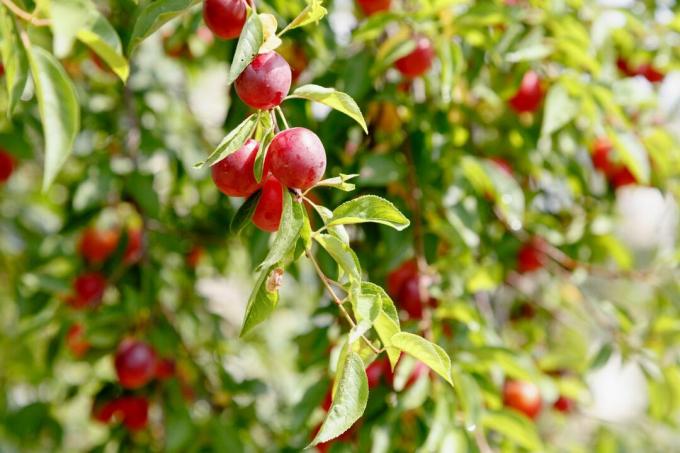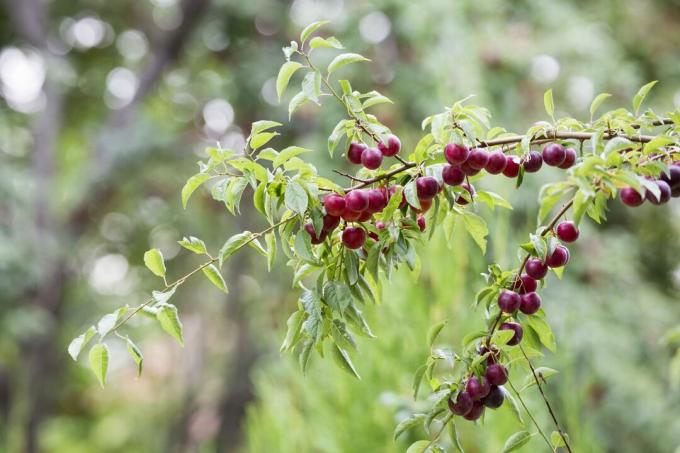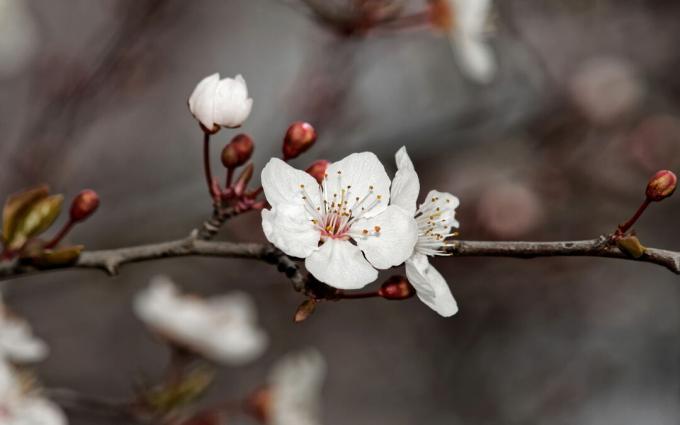Most people only know the cherry plum colloquially as "red mirabelle plum". We explain why this term is actually wrong and show why it is still worth growing these delicious fruits in your own garden.

Have you ever eagerly bitten into a red mirabelle plum and discovered that it tastes very different from its yellow relative? The reason for this is simple: there are no red mirabelle plums. Mirabelle plums are always yellow, at most with red markings. "Red Mirabelle plums" are rather cherry plums (Prunus cerasifera).
contents
-
Origin & characteristics of the cherry plum
- What is the difference between cherry plum and mirabelle plum?
- Is the cherry plum poisonous?
- The best edible cherry plum varieties
- Planting a cherry plum tree: location and procedure
- Proper fertilization and care
- Harvesting cherry plums: when is the time?
- Store and use cherry plums
Origin & characteristics of the cherry plum
The cherry plum was already known to the Celts. It is even older than the plum (Prunus domestica), because this emerged from the crossing of cherry plum and sloe (Prunus spinosa). The plant originally comes from Central Asia, from where it was introduced to Central Europe. Since then it has been used as a base for the finishing of various PrunusSpecies and is therefore often found overgrown in bushes in fruit-growing areas. If you are not familiar with cherry plum, then you could also know the plant under the name “Myrobalane” or “Wilde Mirabelle”.

Cherry plum trees do not grow more than eight meters tall. Instead of growing in height, they tend to grow in width and often even develop multi-stemmed crowns. Sometimes the fine branches of the cherry plum are covered with thorns that hide behind the finely sawn leaves that are up to seven centimeters long.
In the spring, even before this with sloe and mirabelle (Prunus domestica subsp. syriaca) is the case, the intensely fragrant flowers appear. They are white in color, but pale pink on the inside. Due to the early flowering time, cherry plums are important for numerous insects that otherwise do not have many food sources available.
What is the difference between cherry plum and mirabelle plum?
The difference between mirabelle plum and cherry plum is not exactly easy to see.
At the time of flowering, cherry plums can be distinguished from mirabelle plums by their bare flower stalk.
Later, when the two to three centimeters large fruits appear, the fruit color is an important clue. While mirabelle trees only bear yellow fruits, cherry plums can be yellow, red or purple in color. However, the difference becomes particularly evident when inspecting the fruit. While the flesh of the mirabelle plum easily detaches from the stone, the stone of the cherry plum is rather difficult to detach. Cherry plums also taste more sour than the sweet mirabelle plums.

Is the cherry plum poisonous?
Cherry plums are by no means poisonous. The fruits can be enjoyed from the tree as well as mirabelle plums or plums. Whether the taste is a pleasure with cherry plums always depends on the variety. While some trees bear excellent fruit, other cherry plums taste rather bland. It is therefore advisable to taste it once before harvesting.
The best edible cherry plum varieties
The wild mirabelle plum is represented with some notable varieties. However, these are mostly self-sterile and should therefore be planted near other varieties.
- ‘Nigra’: The dark beauty has dark red leaves and pink flowers. The sweet fruits are also very dark red and ripen in August.
- ‘Trailblazer’ / ’Hollywood’: This variety is primarily known for its large fruits with a diameter of up to five centimeters. They ripen in September and are burgundy. The foliage of this variety is also reddish brown.
- ‘Zloty Oblok’: The variety from Poland bears juicy, sweet and extremely aromatic fruits. Similar to mirabelle plums, their fruits are yellow and ripen in September. The tree is quite small and reaches heights between four and six meters.

Planting a cherry plum tree: location and procedure
Cherry plums are often used as a grafting base for other fruit trees because they are quite robust. In principle, almost all floors can be used. The soil should just not be too sandy, but still well drained and have a pH value between six and eight. Cherry plums feel particularly comfortable in the sun or in light shade, where they can not be disturbed by the wind. In addition, the trees are very hardy. When it comes to watering, you can also relax, as cherry plum trees only need water in extremely dry conditions. Only young plants should be given a portion of water every now and then until their roots have sufficiently developed.
So put your cherry plum in a sunny place, either as a solitary tree or in a hedge. The following conditions are ideal for planting a cherry plum tree.
What is the perfect location for a cherry plum tree?
- Well drained soil, not too sandy
- pH between 6 and 8
- Sun or light shade
- The plant is wind and winter hardy
- Plant as a single or hedge plant
Proper fertilization and care
Cherry plum trees do not need further fertilization. They are undemanding and grow extremely well even in the wild without care. However, if you plan to fertilize in order to increase the fruit yield, you should be careful not to use too much nitrogen. One portion is ideal compost in spring or something Plantura Organic universal fertilizer.
To encourage humus formation in the soil, it is advisable to use a soil activator like ours Plantura organic soil activator to work into the earth. This ensures healthy soil life in the long term and creates the ideal growth conditions for your cherry plum.
If you want to prevent your tree from growing wildly, it is important to regularly bring it into shape. A pruning can be done every two to three years or annually for young trees. You can cut the tree after flowering, whereby the cut from diseased or dead branches should always reach back into the healthy wood.
Harvesting cherry plums: when is the time?
Cherry plums usually ripen early, from around June, but the time of ripening varies greatly depending on the variety. For example, the ‘Zloty Oblok’ fruits do not ripen until September. The time of harvest is reached when the fruits are completely colored. Then you should definitely strike, otherwise the pulp will quickly become floury.

Store and use cherry plums
Cherry plums can unfortunately only be stored for a few days. For this it is advisable not to wash the fruits and to store them in a cool and dark place. In the case of soft and almost overripe fruits, it is better to eat them immediately. To keep the cherry plums longer, you can also process cherry plums. Cherry plum jam or jam, for example, taste delicious. However, since the core is difficult to dissolve, you should first boil down the whole fruit and then pass it through a sieve to remove the core.
If you are interested in classic plums in addition to cherry plums, you will find everything you need to know here Planting a plum tree in the garden.

